By Art Merrill | Contributing Editor
Sometimes we run across an out-of-the-mainstream handloading gizmo that reminds us that the pursuit isn’t always mission-oriented – in it we can also find the simple fun of curious experiment. At a mom & pop gun shop a small, used tool recently exchanged places in my pocket with a ten dollar bill and landed on my reloading bench. The tool’s only purpose is to drill a hole into the solid nose of a 22 Long Rifle bullet in an exercise called, “Hollowpointing,” an uncomplicated task even for a beginning handloader.
But, does hollowpointing work? To answer that, we must first ask, well, “What’s the point? What do we expect a hollowpoint bullet to accomplish?”
Expand—sometimes
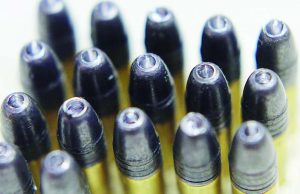
Does hollowpointing 22LR bullets work?
Hollow points on bullets have two purposes: 1.) to promote bullet expansion and subsequently create a larger wound channel when striking soft tissue, and/or 2.) to enhance aerodynamic flight for greater precision (accuracy). Experiments with jacketed bullets apparently discovered the latter phenomenon while investigating the former possibility. Today’s rules of humane warfare (there’s an oxymoron for you) prohibit expanding bullets; the reason we see many military sniper cartridges featuring hollow point bullets is that they are not deliberately designed to expand when striking a human target, rather the hollow point aids aerodynamic flight, and therefore, precision. That’s why jacketed centerfire match grade bullets, as you’ve noticed, frequently sport hollow points even though they’re intended only to punch paper—for competition, the hollow point (HP) is not about terminal performance, it’s about precision flight.
In contrast, note that virtually all 22 Long Rifle bullets lack jackets. Those that sport cladding of a copper alloy are just that – clad, and not truly jacketed. The difference is that cladding is a microscopically thin layer of metal applied to the surface of the lead bullet, rather than the bullet consisting of a thick jacket of metal surrounding a lead slug core. The cladding may reduce lead exposure from handling and leading of a firearm’s bore.
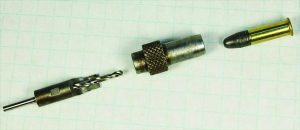
The Cavity Maker tool is simple and easy to use.
Unlike with high velocity jacketed competition and sniper bullets, hollowpoints apparently impart no precision advantage to unjacketed lead round nose bullets at 22LR velocities; if they did, then we’d have to believe that major manufacturers of match grade 22LR ammo have been completely ignorant of this otherwise blatant fact for well more than a century, because all 22LR match ammo features solid round nose (RN) bullets. It seems unlikely that capitalism and the pursuit of precision would miss such an obvious opportunity, and so the presumption stands: hollow points on 22LR do not improve precision, therefore hollow points on 22LR bullets are clearly about expansion.
OK, match grade 22LR has solid RN bullets; there are no 22LR HP match grade bullets. But, what if we could combine the precision of match grade 22LR with expansion to make a primo accurate small game round? More than one imaginative person has believed that no cartridge manufacturer has yet figured that out, and so we have the hollowpointing tool.
Working it
There are quite a few different manufacturers of tools for hollowing the noses of 22LR RN bullets. A quick online check turned up, in no particular order, Li’l Grizzly, Whisperizer, Neal Waltz, Forster and Paco Kelly tools. A couple of these also resize the 22LR bullet as it sits in its case, and so are, ostensibly, accurizing tools, as well as hollow pointing tools.
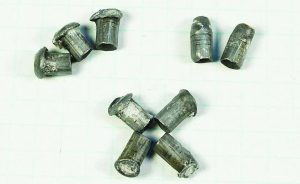
Bullet expansion was not consistent.
The one that found its way into my pocket is the “Cavity Maker” by Ron Allard Enterprise, RFD 2 Box #47 Ware, MA 01062, according to its packaging label. The Cavity Maker tool consists of two pieces, one to hold the 22LR cartridge and the other to drill the hollow point. The drill portion we chuck into a drill motor; we push a loaded cartridge up into the holder, the bullet end of which has a hole/guide for the drill, then hand-feed the holder/bullet nose onto the drill. The drill portion of the tool includes a stop that meets a flat on the cartridge holder to limit the depth of the hole drilled into the bullet. Insert cartridge, drill hole, voilà – we now have a semi-custom 22LR HP cartridge.
We might take a box of 22LR exhibiting ho-hum target precision and see whether hollowpointing shrinks groups, but the uncontrolled variables involved in improving 22LR cartridge precision are so many (precise primer and powder charge, to name only two) that a negative result wouldn’t tell us much. Instead, let’s see whether drilling the hollow point detracts from precision. We can check this well enough to satisfy curiosity by comparing before-and-after groups fired in the same rifle. Let’s open one 50-round box of 22LR Norma Match 22 ammo, hollowpoint half the rounds, then shoot them in a before-and-after, side-by-side test.
From the box, the Norma Match 22 cartridges exhibited, unsurprisingly for match grade ammo, very consistent weight. Weighing 25 cartridges averaged 52.87 grains each, with all cartridges falling between 52.8 and 53.0 grains. After hollowpointing, cartridge weights dropped to an average of 51.77 grains, a loss of 1.1 grains of lead from the drilling.
The tool works as advertised, but needs careful examination for cleaning after each drilling, as a tiny bit of lead inside the tool or left on the drill can cause an irregular hollow point on the next round, possibly affecting performance. Acknowledging that few handloaders have a 22LR shellholder, I found that utilizing mine in a reloading press perhaps aided in achieving a bit more consistency.
From range to field
To see whether hollowpointing affects precision, I fired three five-shot groups of the Norma Match 22 from the box, and three five-shot groups after hollowpointing, all from the bench on a windless morning at 25 yards with a Remington 513T target rifle sporting aperture sights. Each of the bullet configurations shot one one-hole group and spread the other two groups a bit; the hollowpointed groups averaged 1.37”, a bit smaller than the from-the-box group average of 1.86”. While technically an improvement, the reality is that such a tiny difference – and a tiny data sample – is inconclusive, especially given the iron sights and my less-than-perfect vision. My subjective conclusion from this abridged experiment is that hollowpointing of Norma Match 22 makes no difference in bullet precision at practical squirrel-head distance.
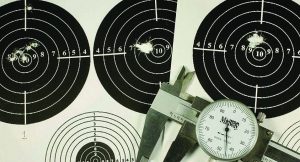
Group averages showed little difference at 25 yards.
Now, let’s get to the point of the hollowpointing: does it promote bullet expansion? The old-school (and least expensive) layman’s test is to shoot bullets into a stack of wet paper to simulate animal tissue. Unerringly scientific it is not, nor did it include firing at different distances to impart different impact velocities. I simply fired nine hollowpointed rounds from a revolver into the test media at about three feet from the muzzle.
Of those nine, three demonstrated optimum performance in expanding into a classic “mushroom” and being recovered nose-forward in the media; four showed some nose flattening that could arguably be called expansion; another ended up sideways without expansion; and the last also failed to expand and had turned a complete 180 in the media with the bullet base forward. All penetrated, in case you’re curious, two to three inches into a fat, wet catalog of (appropriately enough) guns and shooting accessories.
The point?
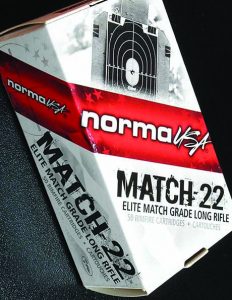
Test ammo was Norma 22 Match.
In the end, the pragmatist will point out, “Hmm…why bother? Just buy hollowpoint ammo.” Granted. Yet the hollowpointing tool is another aspect of handloading that provides the pleasure of experiment and adds to our base of knowledge, which, indeed, was the point of this exercise and which itself opens the door to a lot more enquiry. The curious handloader, for example, may wish to check that precision question by hollowpointing non-match 22LR RN ammo to see if it shoots smaller groups than its out-of-the-box brothers. One might also shoot at longer distances to check both expansion at lower velocities and precision. And the hollowpointing tool does have a justifiably practical application when paired with the 22LR reloading kit covered here in the past (TGM Jan 2015), with which we cast our own lead bullets for the cartridge.
But as we considered at the beginning, handloading isn’t always about being practical, anyway – sometimes it’s just about satisfying curiosity and having fun.



